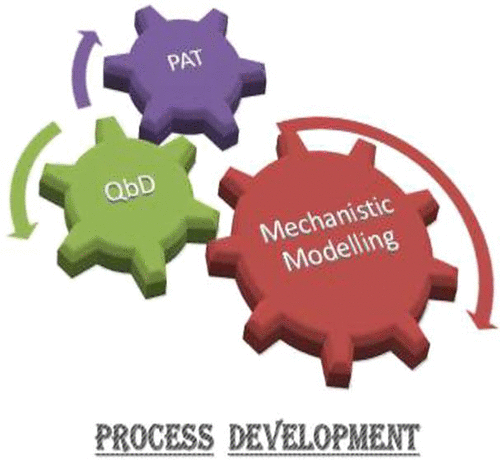当前位置:
X-MOL 学术
›
Cryst. Growth Des.
›
论文详情
Our official English website, www.x-mol.net, welcomes your
feedback! (Note: you will need to create a separate account there.)
Process Development in the QbD Paradigm: Mechanistic Modeling of Antisolvent Crystallization for Production of Pharmaceuticals
Crystal Growth & Design ( IF 3.2 ) Pub Date : 2018-04-25 00:00:00 , DOI: 10.1021/acs.cgd.8b00055 Manu Garg 1 , Milan Roy 1 , Paresh Chokshi 1 , Anurag S. Rathore 1
Crystal Growth & Design ( IF 3.2 ) Pub Date : 2018-04-25 00:00:00 , DOI: 10.1021/acs.cgd.8b00055 Manu Garg 1 , Milan Roy 1 , Paresh Chokshi 1 , Anurag S. Rathore 1
Affiliation

|
Thorough process understanding is a prerequisite for implementing quality by design during development of a pharmaceutical crystallization process. Identification of the critical process parameters and raw material attributes and creation of mechanistic models that can correlate these to the product quality attributes are the first steps in this approach. In this paper, a mechanistic model of antisolvent crystallization has been proposed. The model considers dependence of crystal growth rate on crystal mean size. A risk assessment was performed using Failure Mode and Effects Analysis to identify critical process parameters for designing experimentation. Crystal morphological data required for development of this model have been obtained using focused beam reflectance measurement. MATLAB has been used to identify optimal growth and nucleation parameters. The proposed model compares favorably to other similar models with respect to the accuracy of prediction of crystal size, surface area, and volume, even at varying feedrate profiles of antisolvent during crystallization. The average residual value obtained in given model is of the order of 1/10th of the previous models. The superlative performance likely originates from the fact that most models ignore the size dependence of crystal growth rate. We expect the proposed model to be a useful tool in the arsenal of those involved in development of pharmaceutical crystallization.
中文翻译:

QbD范式中的工艺开发:用于药物生产的反溶剂结晶的机械模型
对过程的透彻了解是在药物结晶过程开发过程中通过设计实现质量的前提。关键工艺参数和原材料属性的识别以及可将这些参数与产品质量属性相关联的机械模型的创建是此方法的第一步。本文提出了一种反溶剂结晶的机理模型。该模型考虑了晶体生长速率对晶体平均尺寸的依赖性。使用故障模式和影响分析进行了风险评估,以识别用于设计实验的关键过程参数。使用聚焦光束反射率测量已经获得了开发该模型所需的晶体形态数据。MATLAB已用于识别最佳的生长和成核参数。就晶体尺寸,表面积和体积的预测准确性而言,即使在结晶过程中反溶剂的进料速度曲线变化的情况下,所提出的模型也可以与其他类似模型进行比较。在给定模型中获得的平均残值约为先前模型的1/10。最高级的性能可能源自以下事实:大多数模型都忽略了晶体生长速率的大小依赖性。我们希望所提出的模型在参与药物结晶开发的人员中成为有用的工具。甚至在结晶过程中使用不同的反溶剂进料速率曲线时也是如此。在给定模型中获得的平均残值约为先前模型的1/10。最高级的性能可能源自以下事实:大多数模型都忽略了晶体生长速率的大小依赖性。我们希望所提出的模型在参与药物结晶开发的人员中成为有用的工具。甚至在结晶过程中使用不同的反溶剂进料速率曲线时也是如此。在给定模型中获得的平均残值约为先前模型的1/10。最高级的性能可能源自以下事实:大多数模型都忽略了晶体生长速率的大小依赖性。我们希望所提出的模型在参与药物结晶开发的人员中成为有用的工具。
更新日期:2018-04-25
中文翻译:

QbD范式中的工艺开发:用于药物生产的反溶剂结晶的机械模型
对过程的透彻了解是在药物结晶过程开发过程中通过设计实现质量的前提。关键工艺参数和原材料属性的识别以及可将这些参数与产品质量属性相关联的机械模型的创建是此方法的第一步。本文提出了一种反溶剂结晶的机理模型。该模型考虑了晶体生长速率对晶体平均尺寸的依赖性。使用故障模式和影响分析进行了风险评估,以识别用于设计实验的关键过程参数。使用聚焦光束反射率测量已经获得了开发该模型所需的晶体形态数据。MATLAB已用于识别最佳的生长和成核参数。就晶体尺寸,表面积和体积的预测准确性而言,即使在结晶过程中反溶剂的进料速度曲线变化的情况下,所提出的模型也可以与其他类似模型进行比较。在给定模型中获得的平均残值约为先前模型的1/10。最高级的性能可能源自以下事实:大多数模型都忽略了晶体生长速率的大小依赖性。我们希望所提出的模型在参与药物结晶开发的人员中成为有用的工具。甚至在结晶过程中使用不同的反溶剂进料速率曲线时也是如此。在给定模型中获得的平均残值约为先前模型的1/10。最高级的性能可能源自以下事实:大多数模型都忽略了晶体生长速率的大小依赖性。我们希望所提出的模型在参与药物结晶开发的人员中成为有用的工具。甚至在结晶过程中使用不同的反溶剂进料速率曲线时也是如此。在给定模型中获得的平均残值约为先前模型的1/10。最高级的性能可能源自以下事实:大多数模型都忽略了晶体生长速率的大小依赖性。我们希望所提出的模型在参与药物结晶开发的人员中成为有用的工具。











































 京公网安备 11010802027423号
京公网安备 11010802027423号